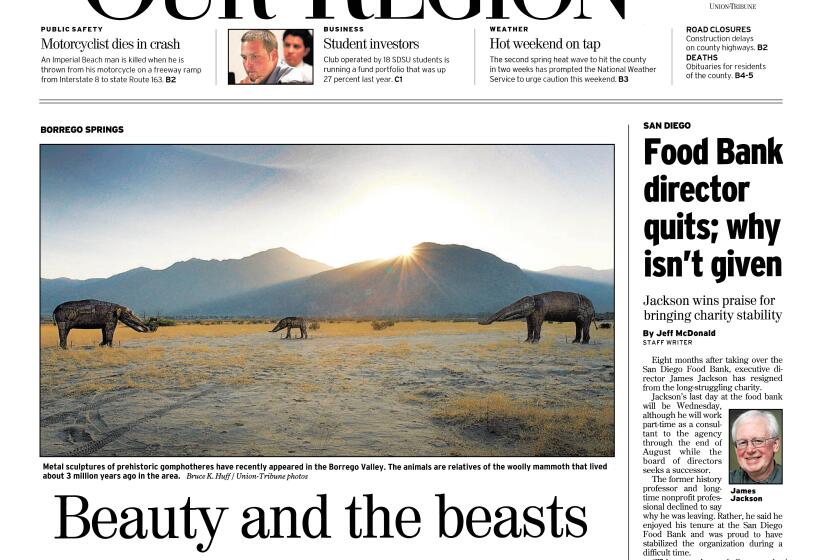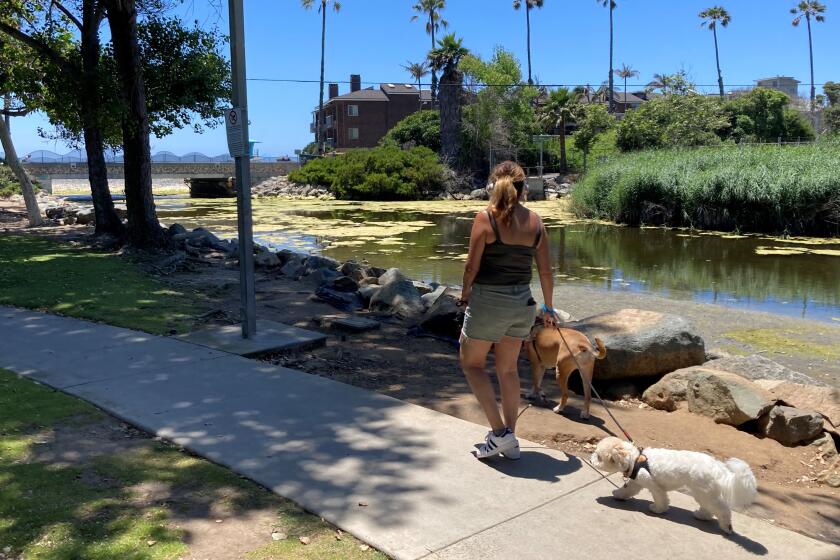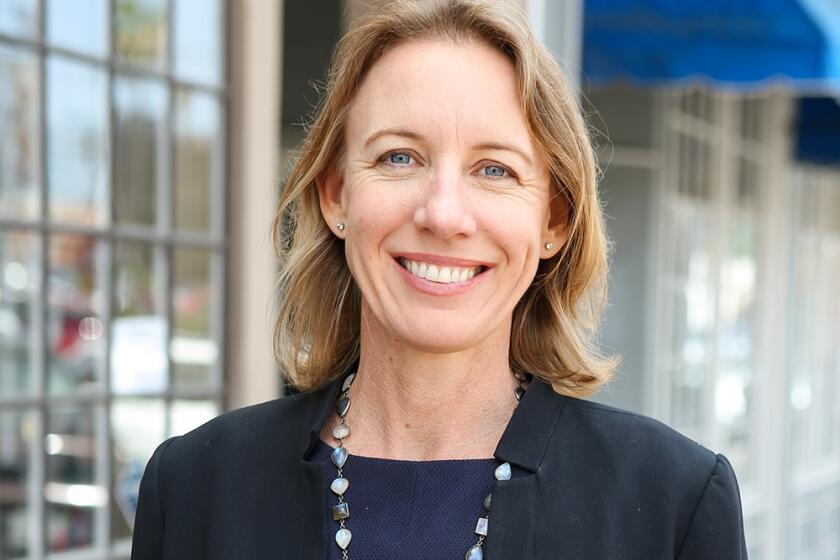Two North County districts contemplating exit from San Diego County Water Authority
Two water districts in northern San Diego County are exploring the possibility of leaving the San Diego County Water Authority and buying their water instead from an agency in southern Riverside County, a move one district says could save it as much as $6 million annually.
It is the first time in the Water Authority’s 75-year history that such a move has been considered by any of its 24 member agencies, officials say, and it likely would be challenged.
Both the Rainbow Municipal Water District and the Fallbrook Public Utility Department have been discussing the move for several months. A lawyer for the Water Authority read a public statement at the authority’s most recent board meeting on May 23, making it public knowledge.
San Diego County Water Authority General Counsel Mark Hattam said in part:
“Our Acting General Manager Sandy Kerl was told on May 21, 2019, by Tom Kennedy, general manger of Rainbow Municipal Water District, that among other things (a) Rainbow .. and Fallbrook ... plan to de-annex from the Water Authority; (b) a deannexation request may be filed with the local LAFCO (Local Agency Formation Commission) as early as June or July; and (c) the question of deannexation may be put to the voters of Rainbow ... and Fallbrook ... in 2020.”
The announcement took Kennedy by surprise. He said he had met with authority representatives a few weeks earlier but had hoped to keep everything quiet a while longer as nothing has been presented to the directors of his or Fallbrook’s districts.
Kennedy said it is true that Rainbow is looking at the possibility of trying to end its relationship with the Water Authority, and instead be annexed to the Eastern Municipal Water District in southern Riverside County. The reason is simple, he said. Eastern charges roughly $1,000 per acre-foot of water while the San Diego authority charges roughly $1,600.
He said switching to Eastern could save $5.5 million to $6 million a year for Rainbow’s customers.
An acre-foot of water is roughly equal to the amount of water used by three to four average California households in a year.
Rainbow expects to buy between 17,000 and 18,000 acre-feet of water this year for its customers, a majority of whom are agricultural in nature. Kennedy said the potential cost savings for the district’s 8,100 customers simply can’t be ignored.
Jack Bebee, Fallbrook’s general manager, also said his district is examining the situation, but that it is too early to say whether his agency will go in that direction.
“The main message we’re trying to get out is this is something we’re looking at to save our ratepayers a lot of money,” Kennedy said Monday. “We want to work with the water authority to come to some sort of an agreement as opposed to having a disagreement.”
The Water Authority has never been shy about going to court to get what it wants. Kennedy said he hopes to work out an agreement with the authority, which could include some sort of exit payments.
Kennedy said Rainbow and Fallbrook, which expects to purchase less than 9,000 acre-feet this year, are in a unique position because they already get most of their purchased water from pipelines owned by the Metropolitan Water District of Southern California, not via pipes owned by the San Diego agency. Both districts, he said, could easily receive only water distributed by MWD pipes in the future with just a few infrastructure improvements.
The main pipeline that brings water into San Diego is owned by MWD until it gets roughly to state Route 76. From there and further south, the pipeline is owned by the San Diego County Water Authority. Most of Rainbow and Fallbrook’s connections are to the MWD part of the pipe.
The difference in the cost of the water is significant because over the past 25 years the San Diego County Water Authority has invested heavily in infrastructure such as a desalination plant, more pipelines and expansion of reservoirs. The debt owed for such projects could be viewed as the responsibility of all 24 water districts that belong to the authority and it is possible the water authority, and its other member agencies, will not look kindly on what Rainbow and Fallbrook want to do.
Should the revenue from Rainbow and Fallbrook no longer go to the authority, the rest of the members might have to compensate by charging even more.
Water Authority Board Chair Jim Madaffer released a statement Tuesday:
“Over the past 20 years, the San Diego County Water Authority has developed one of the most reliable water supplies in California. We are committed to sustaining the region’s $231 billion economy and quality of life for our county’s 3.3 million residents, as we have done for 75 years. We recently received unexpected notice that two of our 24-member agencies -- Rainbow Municipal Water District and Fallbrook Public Utility District – may be planning to leave San Diego for Riverside County.
“As a result, the Water Authority has begun the process of gathering information so that our Board of Directors and all 24 of our member agencies -- and ratepayers in San Diego County -- have the information necessary to make informed decisions. As this matter moves forward, the Water Authority will remain focused on ensuring we continue to provide our customers with reliable water at an affordable price.”
The process of divorcing the water authority could be time-consuming. First, the directors of Rainbow and Fallbrook would have to authorize their general mangers to submit an application to LAFCO, which oversees specials districts. LAFCO would then analyze the request and hold hearings. Should the commission approve the detachment, voters in each district would then have to approve the move.
At the same time the San Diego LAFCO proceedings would be occurring, Riverside County’s LAFCO would also need to consider annexing the districts into the Eastern Municipal Water District.
Kennedy said he thinks voter approval would not be difficult to win as the action would save customers in both districts significant money on their water bills. Kennedy said ideally the votes would happen in November 2020. But that may be wishful thinking.
Keene Simonds, the executive officer of LAFCO, said work on the applications for detachment could be time-consuming.
“There will be some meaty discussions,” he said.
“It’s an interesting dynamic,” Simonds added. “I’ve been doing research on this. As we understand it, nothing like this has ever been formally contemplated before.”
“It is not lost on LAFCO staff that we have to be aware of a precedent on this and how it affects the Water Authority going forward. I’m certainly sure that the Water Authority, in addition to wanting to feel financially whole if this were to go through, will want to have some understanding of how it impacts them going forward long term.”
Kennedy said because Rainbow and Fallbrook are the only districts that can connect directly with MWD pipes, he doesn’t think it would lead to other agencies withdrawing from the authority in the same manner.
“This is something that’s been happening since the inception of our district,” Kennedy said. “We’ve been getting our water from a source in Riverside county and paying the folks in San Diego county for the same water...and the cost gap has been widening.
With his hand on a map, Kennedy pointed to the Rancho California Water District just over the Riverside County line north of Rainbow.
“We’re unique in San Diego County in that we get our water without ever touching water authority infrastructure. We’re much more like Rancho Water to the north and other agencies in southwestern Riverside County.”
Rainbow would have to build some new pipelines in the southern part of its district to disconnect from Water Authority piping. But Kennedy said the cost would be minimal compared to the savings quickly reaped by the switch.
Bebee at Fallbrook said 85 percent of the water it now purchases comes from the MWD pipe and that could be increased to 100 percent without any new infrastructure. The cost savings for Fallbrook, because it purchases about half the amount of water that Rainbow does, would be half what Rainbow thinks it will save.
“We’re preliminary taking a look at it, the economics and the process. No formal action has been taken by our board, but it is something we’re looking at,” Bebee said. “On paper, there is some potential economic saving on water costs, but there are other aspects to it, as well. It’s something we’re looking at and I’m not entirely certain where it will fall and whether the board will decide to move forward on it.”
“Other aspects” could include cash payments to the Authority.
“I don’t want to go to LAFCO with an application until having worked it out with the Water Authority first,” Kennedy said. “I don’t want to bring that dispute to LAFCO’s doorstep. We should sit down and talk about. If they think we owe them something, let’s talk about what that is and maybe there are some fine points we can agree on figuring out.
“LAFCO doesn’t want to be the referee whether we owe x, y, or z,” Kennedy continued. “We could argue that statute says we owe zero. They could argue that we owe $50 million. I don’t know. We haven’t seen the numbers yet.”
The Rainbow Municipal Water District provides water and sanitation services to the unincorporated communities of Rainbow, Bonsall, and portions of Vista, Oceanside and Fallbrook. Sixty-five percent of Rainbow’s customers are farmers.
The Fallbrook Public Utility District is geographically smaller and serves most of Fallbrook and De Luz. The district delivers water to some 35,000 people over a 28,000-square-acre service area.
Both districts have seen a reduction in water consumption the past decade as high water costs have forced some farmers to abandon their avocado groves and other agricultural businesses.
Get North County news in your inbox
Top stories from the San Diego North County every Monday, Wednesday, and Friday.
You may occasionally receive promotional content from the San Diego Union-Tribune.







